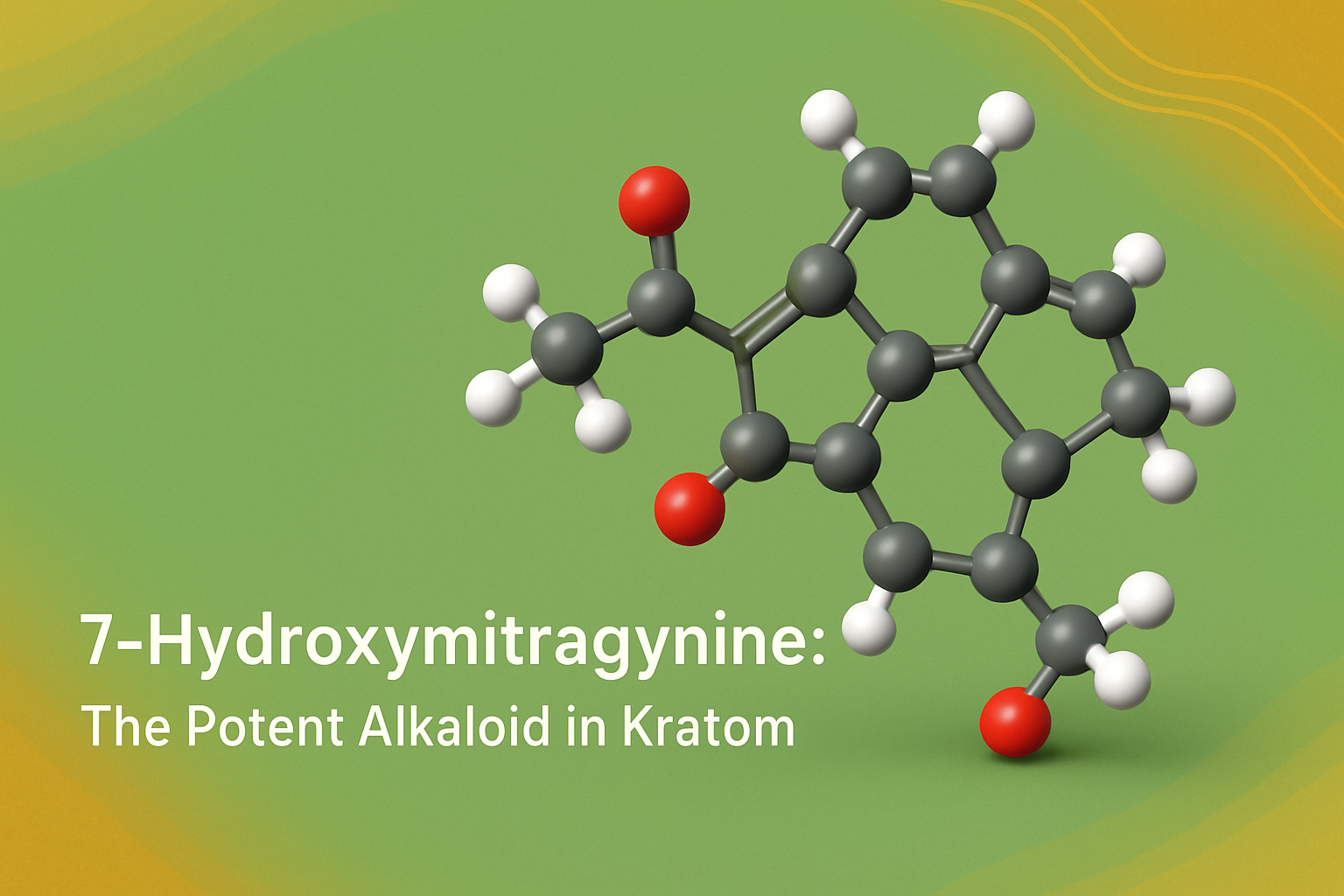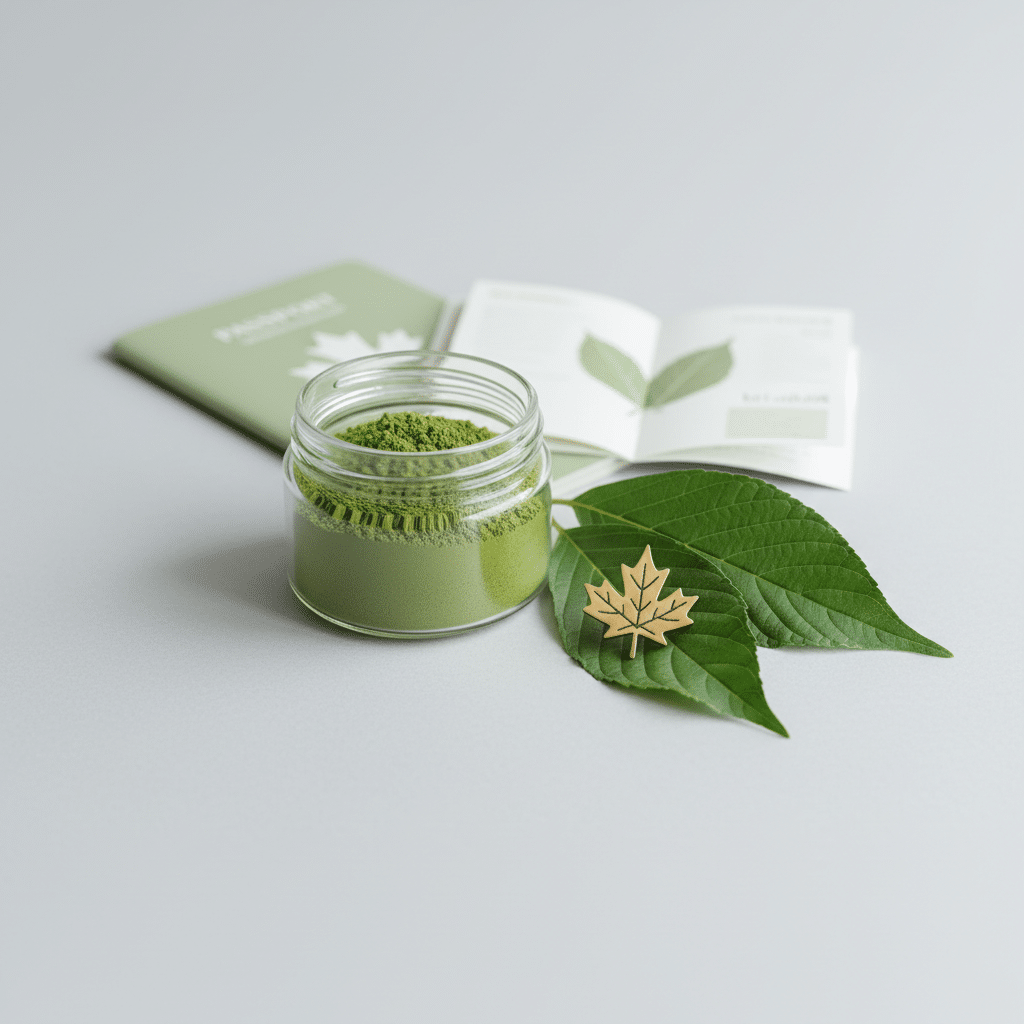
Kratom’s complex alkaloid profile contains over 40 unique compounds, but one minor alkaloid stands out for its remarkable potency. 7-hydroxymitragynine represents just a tiny fraction of kratom’s chemical composition—typically 0.01-0.04% of dried leaf material compared to mitragynine’s higher concentrations—yet research suggests it delivers significantly more powerful effects than its more abundant cousin.
This metabolic byproduct has captured scientific attention for its unique pharmacological properties and potential therapeutic applications. Understanding 7-hydroxymitragynine’s role in kratom’s overall effects provides crucial insight into why different kratom products can produce varying experiences, even when derived from the same plant species.
What is 7-Hydroxymitragynine and How Does it Form?
Chemical Structure and Properties of 7-Hydroxymitragynine
7-hydroxymitragynine belongs to the indole alkaloid family and shares structural similarities with mitragynine, kratom’s primary alkaloid. Its molecular formula C₂₃H₃₀N₂O₅ carries a molecular weight of 414.50 g/mol, making it slightly heavier than mitragynine due to an additional hydroxyl group.
This structural modification fundamentally changes how the compound interacts with biological systems. The hydroxyl group enhances the molecule’s receptor binding affinity and bioavailability compared to its parent compound.
The alkaloid appears as a crystalline solid at room temperature. Its chemical properties make it more lipophilic than mitragynine, allowing greater penetration across biological membranes.
Natural Formation vs Metabolic Conversion in the Body
7-hydroxymitragynine forms through two distinct pathways. Small amounts occur naturally in fresh kratom leaves through enzymatic processes within the plant. However, the majority forms when mitragynine converts via cytochrome P450 3A4 enzymes in the liver after consumption.
This metabolic conversion represents a fascinating example of how the human body transforms plant compounds into more bioactive metabolites. The liver’s enzyme system essentially creates a more potent alkaloid from kratom’s primary constituent.
Environmental factors during kratom processing can also influence 7-hydroxymitragynine formation. Heat, oxidation, and fermentation may convert some mitragynine into its hydroxylated form naturally.
Concentration Levels Across Different Kratom Strains
Laboratory analysis reveals significant variation in 7-hydroxymitragynine content across different kratom varieties. Red-veined strains typically contain higher concentrations than white or green varieties, likely due to their extended fermentation processes.
Processing methods dramatically impact final concentrations. Traditional sun-drying techniques preserve more of this alkaloid compared to high-temperature industrial drying, which can destroy it from measurable levels to trace amounts.
Geographic origin also influences 7-hydroxymitragynine content. Kratom from specific regions of Southeast Asia shows consistently higher levels, possibly due to soil conditions, climate factors, or harvesting practices.
How 7-Hydroxymitragynine Differs from Mitragynine
Receptor Binding Affinity and Potency Comparison
The most striking difference between these alkaloids lies in their receptor binding capabilities. Research demonstrates that 7-hydroxymitragynine shows 5-fold higher oral potency than mitragynine in activating μ-opioid receptors, according to Columbia University studies.
This enhanced potency stems from stronger receptor binding affinity. While mitragynine acts as a partial agonist at opioid receptors, 7-hydroxymitragynine demonstrates full agonist activity with greater binding strength.
The concentration difference becomes less relevant when considering potency. Even though 7-hydroxymitragynine appears in much smaller quantities, its enhanced activity means it contributes disproportionately to kratom’s overall effects.
|
Alkaloid |
Concentration |
Receptor Affinity |
Potency Factor |
|---|---|---|---|
|
Mitragynine |
12-21% |
Partial agonist |
Baseline (1x) |
|
7-hydroxymitragynine |
0.01-0.04% |
Full agonist |
5x higher |
Pharmacological Activity Differences
The alkaloids interact differently with various receptor systems throughout the body. Mitragynine shows complex pharmacology, interacting with opioid, adrenergic, and serotonergic pathways through multiple mechanisms.
7-hydroxymitragynine demonstrates more selective activity. It binds directly to opioid receptors, unlike mitragynine which shows partial and indirect activation patterns across multiple receptor types.
This selectivity may explain why 7-hydroxymitragynine produces more consistent, predictable effects compared to mitragynine’s varied pharmacological profile. The focused receptor interaction creates a clearer dose-response relationship.
Metabolism and Duration of Effects
Both alkaloids follow different metabolic pathways once in the body. Mitragynine undergoes extensive first-pass metabolism, with much of it converting to 7-hydroxymitragynine and other metabolites before reaching systemic circulation.
7-hydroxymitragynine shows greater metabolic stability. It resists breakdown more effectively, leading to longer-lasting effects and potentially higher bioavailability.
The elimination half-lives differ significantly. While mitragynine clears from the system relatively quickly, 7-hydroxymitragynine persists longer, contributing to kratom’s sustained effects profile.
The Role of 7-Hydroxymitragynine in Kratom Effects
Contribution to Pain Management Properties
Scientific research identifies 7-hydroxymitragynine as the primary mediator of kratom’s opioid-mediated analgesic effects, demonstrated in preclinical studies since 2019. Its strong μ-opioid receptor activation provides the foundation for kratom’s pain-relieving properties.
The alkaloid’s analgesic mechanism resembles traditional opioid medications but with important differences. It activates pain-relief pathways while potentially avoiding some side effects associated with conventional opioids.
This selective activity makes 7-hydroxymitragynine particularly interesting for pain management research. Its natural occurrence in kratom provides a plant-based alternative for researchers studying opioid receptor pharmacology.
Impact on Mood and Relaxation Effects
Beyond pain relief, 7-hydroxymitragynine contributes to sedative and mood-enhancing effects through dual interaction with opioid and serotonin receptors. This polypharmacological action explains kratom’s complex psychological effects.
The alkaloid’s interaction with reward pathways in the brain may contribute to kratom’s mood-elevating properties. Users often report improved emotional well-being and stress reduction, effects likely mediated partially by 7-hydroxymitragynine activity.
Its sedative properties become more pronounced at higher concentrations, explaining why red-veined kratom strains with elevated 7-hydroxymitragynine levels produce more relaxing effects.
Strain-Specific Effects and Alkaloid Profiles
Different kratom strains produce varying effects partly due to their unique 7-hydroxymitragynine concentrations. Red strains, with higher levels, tend toward sedating and pain-relieving effects.
White and green strains contain lower 7-hydroxymitragynine levels, allowing mitragynine and other alkaloids to dominate the effects profile. This creates more stimulating, focus-enhancing experiences.
Understanding these alkaloid ratios helps explain why kratom users gravitate toward specific strains for different purposes. The 7-hydroxymitragynine content serves as a key predictor of a strain’s effects profile.
Testing and Quality Control for 7-Hydroxymitragynine
Importance of Alkaloid Profiling in Quality Products
Comprehensive alkaloid profiling has become essential for quality kratom products. Testing reveals not just total alkaloid content but the specific ratios that determine effects profiles, including 7-hydroxymitragynine levels.
Processing methods significantly alter these concentrations. High-temperature drying can destroy 7-hydroxymitragynine from 0.01% to trace amounts, highlighting the importance of proper handling throughout production.
Quality manufacturers implement controlled processing environments to preserve natural alkaloid profiles. This attention to detail ensures consistent products that maintain their intended effects characteristics.
Laboratory Analysis Methods
Advanced analytical techniques like High-Performance Liquid Chromatography (HPLC) and Mass Spectrometry provide accurate 7-hydroxymitragynine quantification. These methods can detect alkaloid levels down to parts per million.
Testing protocols must account for alkaloid stability during storage and handling. Proper sample preparation and storage conditions prevent degradation that could skew results.
Regular batch testing ensures consistency across production runs. Reputable suppliers provide certificates of analysis showing exact alkaloid concentrations, including 7-hydroxymitragynine levels.
Storage and Preservation Considerations
Proper storage plays a crucial role in maintaining 7-hydroxymitragynine stability. Exposure to heat, light, and moisture can degrade this sensitive alkaloid over time.
Optimal storage conditions include cool, dark environments with minimal air exposure. Vacuum-sealed packaging or nitrogen flushing helps preserve alkaloid integrity during long-term storage.
Quality-focused suppliers like 365 Kratom Canada implement strict storage protocols to maintain their products’ alkaloid profiles throughout the supply chain, ensuring customers receive kratom with consistent 7-hydroxymitragynine content.
Research Applications and Future Studies
Current Scientific Research on 7-Hydroxymitragynine
The scientific community continues investigating 7-hydroxymitragynine’s therapeutic potential. 2024 studies are exploring its use as an alternative to traditional opioids for pain management and withdrawal support.
Researchers focus on understanding its unique pharmacological profile compared to conventional opioid medications. This research could lead to new therapeutic applications or synthetic derivatives.
Clinical trials investigating kratom’s effects increasingly measure 7-hydroxymitragynine levels to correlate concentrations with observed outcomes, providing valuable data for future medical applications.
Potential Therapeutic Applications
Current research explores several therapeutic areas where 7-hydroxymitragynine might prove beneficial. Pain management represents the most studied application, given its opioid receptor activity.
Addiction treatment research investigates its potential for opioid withdrawal support. Its partial similarity to opioid medications, combined with its plant origin, makes it an interesting candidate for replacement therapy studies.
Mental health applications remain under investigation. The alkaloid’s mood-modulating effects suggest potential applications for depression and anxiety research, though more studies are needed.
Regulatory and Safety Considerations
Regulatory frameworks continue evolving as research provides new insights into 7-hydroxymitragynine’s safety profile. Different jurisdictions approach kratom regulation with varying degrees of restriction or acceptance.
Safety research focuses on establishing appropriate dosage guidelines and identifying potential interactions with other substances. This work helps inform both regulatory decisions and harm reduction efforts.
Quality control standards development aims to ensure consistent, safe kratom products. These standards increasingly include specific requirements for alkaloid testing and labeling.
Frequently Asked Questions
What makes 7-hydroxymitragynine more potent than mitragynine?
The additional hydroxyl group in 7-hydroxymitragynine’s molecular structure significantly enhances its binding affinity to μ-opioid receptors. This structural modification allows it to act as a full agonist rather than the partial agonist activity seen with mitragynine, resulting in approximately 5-fold greater potency despite being present in much smaller concentrations.
How much 7-hydroxymitragynine is typically found in kratom?
Most kratom samples contain between 0.01-0.04% 7-hydroxymitragynine by dry weight, making it a minor alkaloid compared to mitragynine’s 12-21% concentration. However, this small percentage doesn’t reflect its significant contribution to kratom’s overall effects due to its enhanced potency.
Can 7-hydroxymitragynine concentration levels vary between kratom strains?
Yes, significant variations exist between different kratom strains and processing methods. Red-veined varieties typically contain higher 7-hydroxymitragynine levels due to extended fermentation processes, while processing techniques like high-temperature drying can reduce concentrations dramatically.
How does the body process 7-hydroxymitragynine differently than mitragynine?
While mitragynine undergoes extensive conversion through liver enzymes, often transforming into 7-hydroxymitragynine, the latter shows greater metabolic stability. This means 7-hydroxymitragynine resists breakdown more effectively, potentially leading to longer-lasting effects and improved bioavailability.
What role does 7-hydroxymitragynine play in kratom’s pain-relieving effects?
Research identifies 7-hydroxymitragynine as the primary mediator of kratom’s analgesic properties through its strong μ-opioid receptor activation. Its direct receptor binding creates more predictable pain relief compared to mitragynine’s complex, multi-pathway approach.
Are there quality testing methods to measure 7-hydroxymitragynine levels?
Advanced analytical techniques like HPLC and Mass Spectrometry can accurately quantify 7-hydroxymitragynine concentrations down to parts per million. Quality suppliers provide certificates of analysis showing exact alkaloid profiles, helping consumers understand their kratom’s potential effects profile.
How do processing and storage affect 7-hydroxymitragynine stability?
This alkaloid shows sensitivity to heat, light, and moisture exposure. Proper processing methods that avoid high temperatures help preserve natural levels, while optimal storage in cool, dark conditions with minimal air exposure maintains alkaloid integrity over time.
Conclusion
7-hydroxymitragynine represents a fascinating example of how minor plant compounds can exert major biological effects. Despite comprising less than 0.05% of kratom’s total alkaloid content, this metabolite contributes significantly to the plant’s pain-relieving and mood-modulating properties through its potent opioid receptor activity.
Understanding the role of 7-hydroxymitragynine helps explain the varying effects across different kratom strains and processing methods. Quality testing and proper handling preserve these crucial alkaloid profiles, ensuring consistent product experiences.
As research continues expanding our knowledge of kratom alkaloid metabolism and therapeutic applications, 7-hydroxymitragynine will likely remain a key focus for scientists studying plant-based alternatives to conventional pharmaceuticals.
Ready to explore premium kratom products with verified alkaloid profiles? Browse 365 Kratom Canada’s collection of lab-tested kratom blends, including Relax and Goodnight formulations designed for optimal relaxation and pain management support.


